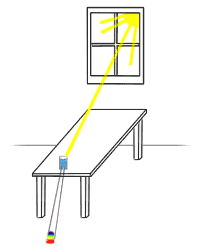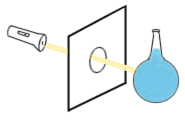What Causes Rainbows?
Everyone has seen a rainbow. They are arguably one of the most beautiful displays of nature, and they seem to come in many different sizes, situations, and settings. But what is a rainbow? If you ask, most people will say that a rainbow is "light going through raindrops or something". This is correct, but it's not the complete answer. In this activity we will learn how and why rainbows form and how you can make one yourself.
Required Materials
A water glass
A flashlight, or other directed beam of light
A round-bottomed flask, or some spherical glass container (a round fishbowl would work)
A small piece of cardboard or poster-board that fits over the head of the flashlight
A 10"x14" piece of white poster-board
Activity Directions
- Place the glass filled with water near the edge of a table that is bathed in sunlight. As in the drawing below, a "rainbow", or spectrum, should appear on the floor near the glass. If the sun is low on the horizon, look for the spectrum on the wall!
- What is the glass and water doing to the light?
- Let's repeat our experiment with the water and the light. This time we need to use the round container, the flashlight, and the small and large pieces of cardboard.
- Cut a narrow slit in the small piece of card/poster board and tape the piece to the head of the flashlight, so that only a small beam of light emerges.
- Now cut a fist-sized hole in the middle of the large piece of poster-board. Also fill the spherical container with water.
- Shine the narrow beam of light from the flashlight through the hole in the poster-board and onto the container. You may need an extra person to hold the container while you shine the light and hold the white poster-board.
- What do you see on the container-side of the poster-board as you shine the narrow beam of light onto the water-filled flask? Can you position the flashlight and container so that you see a spectrum on the white paper?
- What is the shape of the spectrum on the piece of poster-board? How is this similar to a rainbow in the outdoors? How is it different?
- If you have access to a garden hose, a sprinkler, and a water spout, go outside and try to make your own rainbow!
- Get a fine misting sprinkler and set the water pressure high enough to get a large volume of water droplets in the air.
- Based on what we've learned up to now, where should you stand with respect to the water and the sun?
- Find the shadow of yourself on the ground. Try to measure the angle from the shadow of your head to the rainbow arc. Use the "hand and fist" method to measure this angle: if you stretch out your arm and make a fist, the width of your fist is about ten degrees; the width of a finger at arm's length is about two degrees. Try it!


Want to Learn More? Read an article related to this activity:









